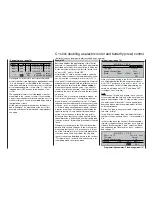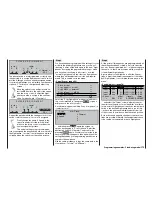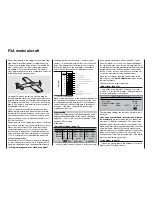
178
178
Programming examples: Fixed-wing model
extent to which AILE and FLAP follow the
movement when the C1 stick is moved. The
aim is for the airbrakes to move up “slight-
ly” and both fl aps to defl ect down as far as
possible.
Pressing
the
HELP
button with the rota-
ry control pressed in will show you the ser-
vo travels, and – in particular – will illustrate
that the C1 control has no effect on the wing
fl aps above the previously selected brake
offset of 90% (“dead zone” of the C1 stick).
Check all the wing fl ap travels once more, and adjust
the servo centres, servo travel and travel limits in the
»
Servo adjustment
« menu if necessary.
When you have completed the non memory specifi c
(i. e. global) settings up to this point, you are probably
ready to consider fl ying the model again.
In the following section we show how to set up
two more fl ight phases, each of which demands
slightly different wing fl ap settings.
However, since we previously set up the “Brake set-
tings” in the “normal” fl ight phase, and have optimised
these values, we must now ensure that the transmit-
ter automatically switches to the “normal” fl ight pha-
se when the C1 stick is moved in the “brake” direction;
this step must be completed before you set up the
new fl ight phases.
Assuming that you have changed nothing in the de-
fault assignment of the C1 stick for the control swit-
ches G1 and G2, we now move directly to the »
Logi-
cal switches
« menu. If this is not the case, you must
fi rst program a suitable control switch in the »
Con trol
switches
« menu, using the procedure described on
page 94.
»Logical switches« (page 97)
First activate the left hand
fi eld (already high-
lighted), then locate the three-position switch you
one of the side-mounted proportional cont-
rols, then you should assign the appropriate
transmitter control to Input 6 in the »
Trans-
mitter control adjust
« menu. In this menu
you would then set the desired response to
a movement of the transmitter control selec-
ted for this purpose, in the form of a percen-
tage value.
El
Fl
: This mixer causes the ailerons (AILE) and
fl aps (FLAP) to defl ect
when an elevator
command is given
.
The mixer direction must be selected to
ensure that up-elevator causes all the wing
fl aps to defl ect down, and down-elevator
causes up-fl ap. The usual values for this mi-
xer are in the low two-digit range.
Pressing the
HELP
button with the rotary control
pressed in takes you to the »
Servo display
«, where
you can check the settings you have completed thus
far.
Now move on to the “
Brake settings
”, staying within
the »
Wing mixers
« menu:
WK2
+30%
0%
+80%
+50%
0%
=>
+40%
AILE
FLAP
Crow
B R A K E S E T T I N G S
Elevat. curve
Diff. reduct.
Note:
The “Brake settings” menu is switched “off” if you en-
tered “Motor on C1 forward / back” in the »
Model
type
« menu (see page 70), and leave “yes” for the
currently active fl ight phase in the “Motor” column of
the »
Phase settings
« menu (see page 100). You may
therefore need to switch fl ight phases.
Crow
:
Earlier we selected the C1 stick for airbrake
control. At this point you can determine the
meter values it is important to check that the
ailerons defl ect in the correct “sense” (direc-
tion).
The adjustment range of -100% … +100%
enables you to set the correct direction of
travel as well as the desired aileron travels.
Ail-tr
:
At this point you determine the extent in
percentage terms of
the effect of aileron
trim
on AILE and FLAP.
Diff.
:
At this point you enter the
differential for
the aileron control system
of the AILE and
FLAP surfaces. Please see page 111 for an
explanation of aileron differential.
The adjustment range of -100% … +100%
enables you to set the correct direction of
differential regardless of the direction of ro-
tation of the aileron and fl ap servos.
Fl.pos
: In this line you set the
fl ight phase specifi c
fl ap positions
for all the wing fl aps (ailerons
and camber-changing fl aps) present on
your model. This enables you to determine
the position the fl aps take up in each fl ight
phase.
Note:
The values which appear in this line refer
back to the same data set used at the com-
parable position in the »
Phase trim F3B
«
menu, for which reason any changes you
make here affect both menus.
FL
: Since the default settings for all inputs in
the »
Transmitter control adjust
« menu is
“free”, neither the ailerons nor the fl aps can
be operated until you have entered values
at this point. You can therefore leave the de-
fault entries unchanged for the moment.
However, if you wish to be able to vary the
fl ap positions relative to the setting selec-
ted in the “FL.pos” line, using a switch or
Summary of Contents for mx-24s
Page 1: ...1...
Page 19: ...19 For your notes...
Page 35: ...35 For your notes...
Page 41: ...41 41 For your notes...
Page 57: ...57 For your notes...
Page 63: ...63 63 For your notes...
Page 69: ...69 69 For your notes...
Page 85: ...85 85 For your notes...
Page 99: ...99 For your notes...
Page 143: ...143 For your notes...
Page 191: ...191 For your notes...
Page 212: ...212 212 For your notes...
Page 213: ...213 213 For your notes...
Page 214: ...214 For your notes...
Page 216: ...216...
















































